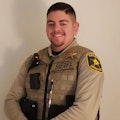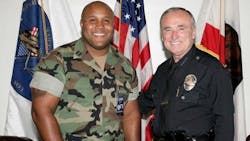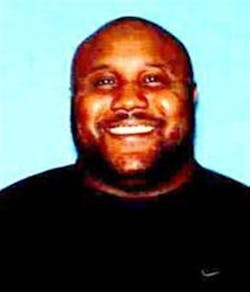How to Catch A Criminal: From the Outside Looking In
Christopher Dorner was born in 1979 in New York and raised in Southern California. After graduating high school in 1997, he furthered his education at Southern Utah University, where he played football as well. In 2002, Dorner became a Naval Reservist, eventually obtaining the rank of lieutenant. During his service he was awarded a Rifle Marksman Ribbon, and a Pistol Expert Medal. In 2005, Dorner was hired by the Los Angeles Police Department and entered the Police Academy. During his time in the academy, he was accused of hitting another recruit, negligently discharging a firearm and arguing with Instructors, but nonetheless he graduated in 2006. In 2007, after a 13-month Naval deployment, Dorner resumed his field training with LAPD. Based on his background, Dorner seemed set to exceed as an officer. A college-educated, military-trained, firearms expert, who valued the integrity instilled in him by his time as a reservist. The 28-year-old rookie policeman had a bright future ahead of him. However, in July of that year, a simple unwanted subject call would be the catalyst for a multi-year battle which would break Christopher Dorner.
On July 28, Dorner and his training officer, Teresa Evans, responded to a hotel in San Pedro to remove a man who was causing a disturbance. The man suffered from Schizophrenia and Dementia and was apparently having a mental health crisis. During their interaction with the man, he threw a punch at the officers and was shock with a Taser. He was then handcuffed and arrested. Life went on as usual for the next two weeks, until Dorner received a less than stellar evaluation from Evans. He was told he needed to improve his report writing, officer safety and judgment, otherwise, he would be given an unsatisfactory review. The following day Dorner complained to a sergeant that during the hotel arrest, Evans repeatedly kicked the mentally-ill man while he was on the ground handcuffed. An investigation was opened into the incident, and after seven months, it was concluded Dorner had lied. Three witnesses at the hotel stated they did not see the kicking, and the alleged victim was not able to adequately recount what happened during the incident. A disciplinary board found Dorner’s claims were not credible, and he likely made up the story to get back at Evans for the damming evaluation. As a result, he was terminated. Having his integrity, which he claimed to value so much, brought into question, was more than Dorner could handle. Dorner’s attorney, former LAPD Captain Randal Quan, did his best to prove Dorner’s innocence, but to no avail. Through several appeals to higher courts, the decision to terminate was upheld, with the final appeal ending in 2011. For the next year and a half, Dorner stewed about what he believed was wrongful treatment by his former department. In his mind, he had only done the right thing, and was punished for it. In February 2013, Dorner decided he still needed to clear his name, but conventional methods were no longer an option.
On February 1, Dorner received an honorable discharge from the Navy, and on that same day, CNN anchor Anderson Cooper received a package from Dorner containing an LAPD challenge coin with several bullet holes through it and a note attached claiming the coin was shot at 100 yards, showing off his marksmanship abilities. The package also included a DVD of an interview with the alleged kicking victim, and a note insisting Dorner did not lie.
February 3, 2013, Irvine California. Monica Quan, the Daughter of Dorner’s former attorney, and her fiancé Keith Lawrence, were shot to death in Lawrence’s car outside their condo. The motive behind the murder was initially unclear, as the pair had not been robbed of their valuables. On February 4, Dorner published an 11,000-word post on social media, addressing it to America, explaining he had exhausted all means of restoring his reputation. He detailed multiple officers he planned to kill and stated he would only stop when the “truth” came out. He also made it clear he did not care if he survived his mission.
Dorner mentioned in the manifesto he felt Randal Quan deliberately threw the case to protect LAPD. Due to this fact, he was named the prime suspect in the Quan and Lawrence homicides. The search for Dorner was on, and his last known whereabouts were discovered to be a February 5 check in at a hotel on Naval Base Point Loma in San Diego. It was soon learned he left without checking out, and he could now be anywhere, waiting for the right time to kill his next target.
Citing the danger to the officers on Dorner’s it list, LAPD set up round the clock protection details for the targets until Dorner was caught. Citizens were asked to immediately contact Police if he was spotted, and advised not to approach him because he was armed and extremely dangerous. Dorner’s name and face filled television, radio and online news, drawing thousands of tips regarding his location.
On February 7, in the early morning hours, two officers en route to a protection detail in the Corona area were notified by a citizen a man matching Dorner’s description was at a nearby gas station in a pickup. The officers located the truck and followed it before the suspect pulled over and jumped out the vehicle firing a rifle. One officer was struck in the head, but survived his injury. The suspect escaped in the truck, and shortly after, struck again. Two Riverside Police Department officers were stopped at a red light in their vehicle when a male ambushed them, shooting them both, killing Officer Michael Crain. Now with three victims dead, including an officer, panic truly set in. Anyone could be next, whether they were on the list or not, whether they were an officer, or an officer’s family member.
As the search continued for Dorner, two officer-involved shootings occurred involving pickups similar Dorner’s. Two women delivering newspapers were shot at in Torrance. They luckily survived their injuries after over 100 rounds pierced their vehicle. Later, a male driver was and shot at in his truck, and another was injured when his truck was rammed by officers before shots were fired, though he did not suffer any gunshot wounds. Tensions were extremely high and officers were desperate to find Dorner before he killed again. His war against law enforcement was not just fought with bullets. It was psychological torture. He knew how police operate and what they fear. That combined with his military training made him a highly skilled survivalist in many environments. The chief of the LAPD at the time, Charlie Beck, was quoted as saying “Of course, he knows what he’s doing. We trained him.” Dorner may not have been an officer for long, but he was able to watch them, predict their next moves, cover his tracks, and evade capture. He was not a standard criminal. He was an inside man, hunting from the outside.
The manhunt spread south of the border after law enforcement learned Dorner attempted to convince several fisherman in San Diego to take him to Mexico. Dorner eventually gave up on being polite, threatening one boat owner with a gun and tying him up. He was unable to successfully operate the boat and fled the marina. Days later a hotel in Tijuana, Mexico, was raided after a possible Dorner sighting, but he was not located.
The wilderness of the greater Los Angeles area remained the main target for the search after Dorner’s truck was located in Big Bear around 8:30 a.m. on February 7. The truck, containing several guns, camping supplies and large amounts of ammunition, had been set on fire in an apparent attempt to destroy evidence, but was later positively identified by the VIN. When officers initially located the vehicle, they did not approach. They knew it could be a trap and Dorner may be nearby waiting to pick off anyone who came near. The surrounding area was searched and the vehicle was removed with the use of an armored vehicle. Businesses and schools in the area were locked down. Officers set up checkpoints and began going door to door looking for leads on Dorner. Helicopters and UAVs were deployed to search from the air. Bloodhounds tried to track his scent. A $1,000,000 reward was offered. From the morning of February 7 to noon on February 12 there was no sign of Dorner, and terror had spread
February 12, 2013, 12:22 p.m. Officers responded to a carjacking in Big Bear Lake. The driver stated he was held at gunpoint by Dorner, who stated he did not want to hurt him and ordered him out of the vehicle. Dorner left in the vehicle and was soon spotted by Game Wardens. He opened fire on them with his AR-15 rifle. They chased him through the mountains, losing sight of him as countless officers began descending on the area now that word had spread of Dorner’s whereabouts. As officers searched for the truck, bullets began flying from the window of a cabin. Dorner had abandoned the vehicle and taken up a sniping position inside the residence. Two San Bernadino County Deputies were shot, with one surviving, and Detective Jeremiah MacKay being pronounced dead after air transport to a hospital.
There was no doubt; Christopher Dorner had been found. His only slip up: allowing an innocent civilian to live after a carjacking. Countless law enforcement personnel surrounded the cabin, taking cover as Dorner unleashed periodic fusillades, avoiding incoming fire. Orders for Dorner to surrender were given via loudspeaker, but there was no response. Tear gas was launched inside in hopes of smoking him out, but Dorner did not relent. An armored vehicle was used to tear into the home to give a better view of the interior, but Dorner was not spotted. Soon, a smoke canister was popped from inside the house. Dorner seemingly expected officers to rush in after the use of the armored vehicle and hoped to blind them with the smoke. There was no end in sight to the stand off. Dorner was well equipped and knew how to survive in harsh conditions. He made it clear in his manifesto he did not plan to live long enough to see his name cleared. SWAT command staff made the decision to fire CS gas canisters into the house. These canisters were known to reach high temperatures which could cause a fire. Much like the Branch Davidian compound in Waco Texas, the gas ignited the residence. Dorner stood by his word that he would not survive his mission, shooting and killing himself as the house burned down around him.
Law enforcement are taught techniques and tactics which make them effective servants to the public: investigative skills, self-defense techniques, firearms discipline and more, to be used to defend law abiding citizens from the dangerous, depraved, and desperate. The case of Christopher Dorner served as a sobering lesson of what happens when those skills are used to terrorize and kill rather than to serve and protect.
About the Author

Officer Brendan Rodela, Contributing Editor
Brendan Rodela is a Sergeant for the Lincoln County (NM) Sheriff's Office. He holds a degree in Criminal Justice and is a certified instructor with specialized training in Domestic Violence and Interactions with Persons with Mental Impairments.

